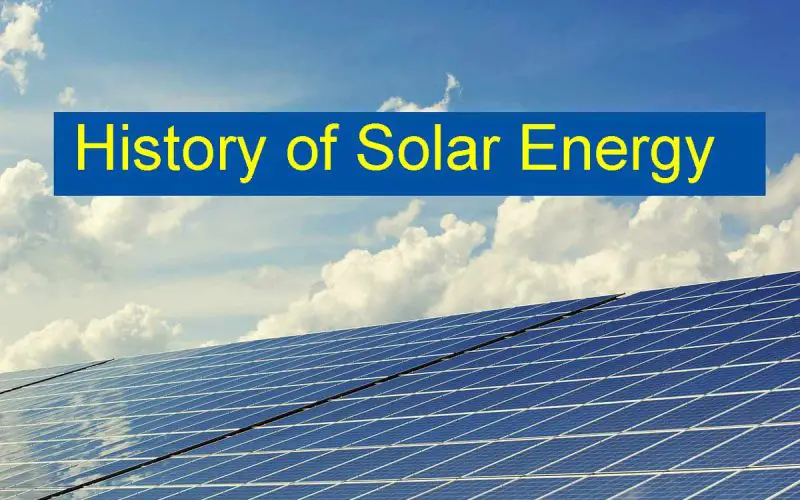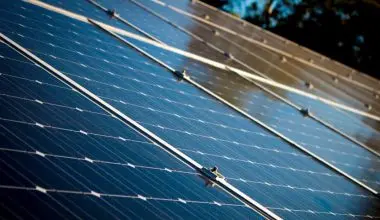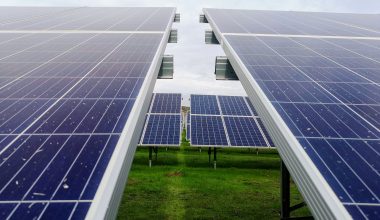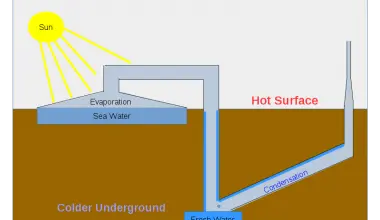Table of Contents Show
Solar Energy did not just develop overnight.
Its understanding developed through multiple stages of human civilization (centuries).
At first we noticed that sun rays had light and heat energy. Then we tried harnessing that energy to concentrate heat or make fires.
It wasn’t until 1839 when Becquerel noticed the photo-voltaic effect that produces electricity. Those methods developed so much that we now have very efficient methods of converting solar energy into electricity and use it to power homes, offices and factories.
This was a great win when it comes to Solar Energy, Let’s look at other wins we’ve had in terms of solar power over the past few centuries.
Simple Infographic on History of Solar Energy
I’ve covered major milestones in development of the solar industry in this infographic below!
This is so you can understand how solar power developed enough to supply 505 GW of electricity to the world!
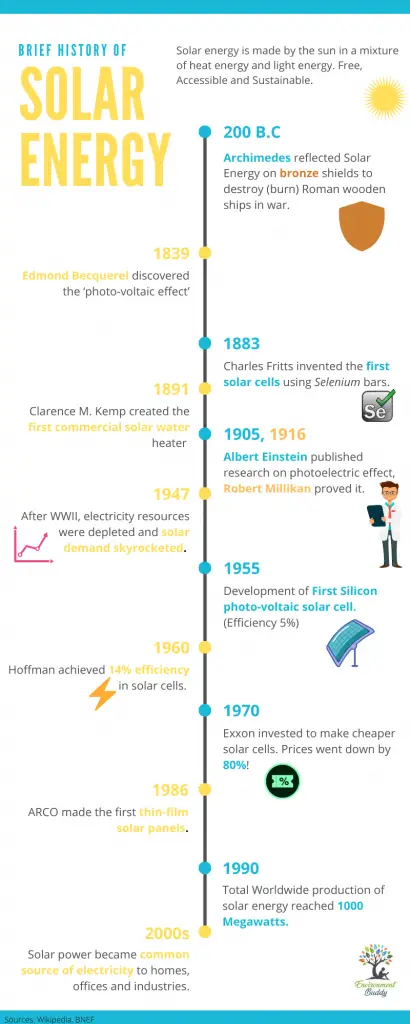
Detailed Historical Timeline of Solar Energy
This will tell you how Solar Energy basically evolved overtime.
During B.C. Era
Early 200 B.C, A Greek scientist called Archimedes, used bronze shields to reflect light onto the roman ships during war. The wooden ships burned because of presence of heat energy in solar rays.
In the 700 B.C. Humans learned to focus the heat using a magnifying glass. The focused sun rays were used to burn wood to make fire or to burn ants.
1700’s
In 1767, A Swiss scientist made what is known as a ‘solar collector’ (like an oven), later used by a traveler to cook food during his expedition.
The Oven was created by making an insulating box which was surrounded by three thick glass layers to concentrate solar heat energy. It could reach temperatures above 200 Degrees Fahrenheit!
1800’s
In the 1800’s, Augustin Mouchot performed experiments on the heat energy aspect of the solar energy and shared the idea of solar powered steam engines.
Also, Robert Stirling made heat engines which were later a part of the dish/sterling system which worked by concentrating heat from solar energy and producing power.
1839; Edmond Becquerel discovered the ‘photo-voltaic effect’ when he realized that some materials would exhibit a change in Voltage when exposed to light energy. He found this in an electro-chemical cell.
in 1873, Willoughby Smith found out the photo-conducting property of Selenium.
in 1876, Professor William Grylls Adams and Richard Evans Day found out the ability of Selenium to produce electricity by shining light onto it. This was the first time it was proved that electricity could be made from light energy without the use of an engine of some sort.
However, the electrical energy produced was not enough to power any electrical appliances at the time.
1883: An American scientist Charles Fritts invented the first cells with the solar photo-voltaic effect using selenium bars.
1887: A German Physicist Heinrich Hertz noticed the ability of one electrode to spark electricity with another electrode in the presence of U.V rays (Ultraviolet light, present in solar rays).
1891: Clarence M. Kemp created the first commercial solar water heater.At the time it was a very simple system of an insulated black box with one side made of glass to heat up water in the tank.The commercial solar water heaters sold today are quite efficient and affordable.
1900’s
1904: Wilhelm Hallwachs found out that the mixture of copper with cuprous oxide is photo-sensitive (reaction in the presence of light).
1905: Albert Einstein produced his research paper on the photoelectric effect. Basically regarding how it works.Also, the theory of relativity paper was published around the same time.
1908: William J. Bailley who worked in the Carnegie Steel Company made a collector of solar energy which had copper coils in an insulated black box. This design has stayed roughly the same.
in 1914, we found out that there was barrier layer in the photo-voltaic devices.
in 1916, Robert Millikan proved the photo-electric effect from his experiments.
in 1918, A Polish scientist Jan Czochralski worked out the way to grow a single-crystal silicon. This is the basis on which the modern silica-based solar cells that are present in solar panels are made.
1932, Two Scientists found out the photo-electric effect present in Cadmium Sulfide.
in 1947, After the World war II, the electricity resources were depleted and hence solar equipment became quite in demand.
1953-1955: Multiple scientists including Dr. Dan Trivich of the Wayne State University (theoretical work in 1953), Calvin Fuller, Gerald Pearson, and Daryl Chapin worked into developing the first silicon-based photo-voltaic solar cell which could power small electrical devices such as dollar bill changers.
These products initially had efficiency below 5% but later got updated to 11%. Today we have many portable solar devices such as solar calculators, solar watches, solar chargers and whatnot.
1956: By this time, Solar cells were available in the markets but were too expensive to be bought, with each 1 Watt solar cell costing as much as 500 Dollars! However, William Cherry proposed using photo-voltaic cells on the upcoming satellites that would be orbiting the earth.
1958: Solar cells started being used in satellites and space stations. n-on-p silicon cells were made specially for satellites as they were more resistant to radiation.
1960’s: Hoffman Achieves 14% efficiency in it’s photo-voltaic solar cells. NASA worked on making satellites including Nimbus with higher power of photo-voltaic panels (up to 1 kW) for research.
1970’s: Exxon Corporation invested into developing significantly cheaper solar cell, which brought the price down from $100 per watt to $20 per watt. This reduction in price led to the use of solar cells in warning lights and horns that were being used in many off-grid installations in remote areas, like railroad crossings.
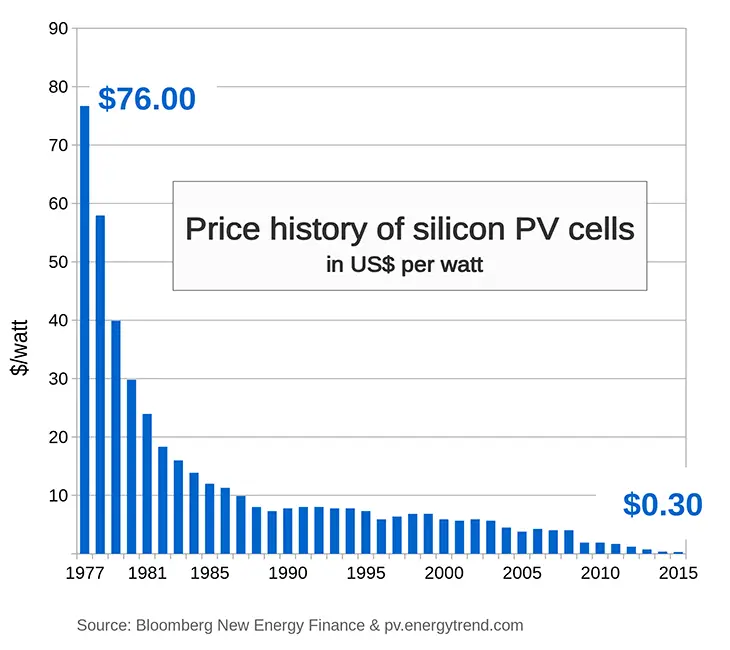
The first amorphous silicon photovoltaic cells were developed in 1976. Also, the U.S government opened doors to the Solar Energy Research Institute in ’77.
1980’s: Solar power became popular in the markets and widely used in many everyday use items such as remotely located homes and telecommunication towers, railroad crossings, irrigation systems, solar-powered cars (Volkswagen started testing photovoltaic arrays on roofs of Dasher Station Wagons) and large scale solar-based power plants.
ARCO made the first thin-film solar panels which hit the markets in 1986. Worldwide power production from solar energy went above 21.3 megawatts with solar equipment sale amounting to $250 Million.
1990’s: George Bush renamed the U.S Department of Energy’s Solar Energy Research Institute as the National Renewable Energy Laboratory located in Golden, Colorado today.
By the end of 90’s, The Efficiency of thin-film solar cells went higher than 35%.
Pacific Gas and Electric made the first on-grid 500 kW solar system which was the first attempt at distributed source of power between solar and grid. This later went on to become the basis of net-metering systems that we have today.
Total Worldwide production of solar energy from photo-voltaic capacity reached 1000 Megawatts.
2000’s
First Decade of 21st Century
Initially in 2000, Safer inverters were developed by Sandia National Laboratories which are used by solar systems to convert the Direct Current (DC current) made by solar systems into Alternating Current (AC) which is the standard form of electricity used in wiring as well as household appliances.
NASA’s solar powered aircraft named Helios broke the world record as the first plane to fly without being powered by rocket fuel. NASA also manufactured the aircraft Pathfinder Plus around the same time which was used for aerial surveillance by coffee-growers.
After 2010
Large-scale solar power plants started becoming common around the world. Most developed countries started opting solar energy for industrial use. An example would be the Golmud Solar Park in China that produces 200 MW single-handedly.
Today, Solar power is a common source of electricity to power homes, offices and even industries. Solar technology is gradually paving the way for a sustainable future for the world.
As Solar energy is the most cost-effective and efficient source of electricity, it should be promoted wherever possible so we can try and have a low-carbon future.
Future of Solar Energy
We can expect solar energy to have a very bright future. Buildings are expected to have a design that would be highly energy efficient and would be completely dependent upon renewable sources of energy. This will lower the demand of non-renewable energy and the pressure on extraction of fossil fuels from the Earth.
The research into photovoltaic systems would promote the production of energy from many everyday-use items such as clothes and automobiles that produce energy as they move.
Development of newer ,more efficient and hopefully cheaper solar equipment including solar cells, solar panels and even inverters.
Just recently, scientists from Norway and Switzerland published a paper about how large-scale floating solar farms (a.k.a solar methanol islands) could be used to produce hydrogen and extract carbon dioxide from seawater to make methanol chemically which then could be used as fuel. If this were to be successful, on a larger scale it would reduce the green-house gas emissions in the atmosphere.
